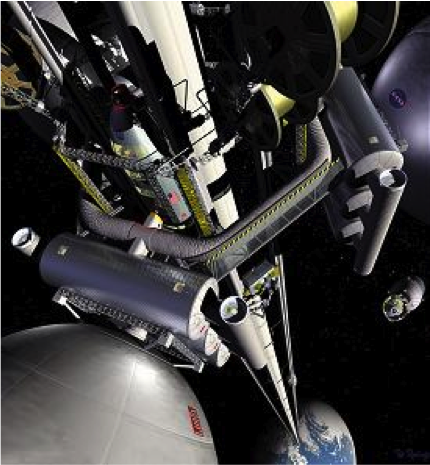 |

|
 |
CGI courtesy of NASA. |
|
How cool would it be to ride an elevator into space? Amazing…. but science fiction, right? Maybe not. MSE Professor Lourdes Salamanca-Riba suggests that such a device could be possible in this era, and she’s not alone. NASA has been looking into developing a space elevator for quite some time. Such a mechanism would make space transport (of materials, people, etc.) more efficient and more cost-effective, without contributing to pollution; however, numerous challenges – including cost, security and most importantly, lack of appropriate materials – have kept project development at bay.
Dr. Salamanca-Riba has been studying a material called graphene – an exceptionally strong material (estimated to be 200 times the strength of steel) with high electrical mobility and flexibility, in addition to being incredibly light-weight. Carbon nanotubes are sheets of graphene rolled up into a tube. Thus far, carbon nanotubes, devoid of defects, are only available up to a few centimeters in length. A space elevator would require an estimated 60,000 km (37,000 miles)-long cable of carbon nanotubes, which will take lots of time and money to build.
“Building a space elevator will be very expensive,” said Salamanca-Riba. “However, once it is built it will be a lot cheaper to send people or cargo into space than it is now. Currently, it costs about $10,000/pound to send something into space. With a space elevator, it should be less than $1/pound.”
The elevator would essentially consist of a base platform, extending roughly 50km off the ground, somewhere along the equator (where high winds are less likely to affect it). A cable, made of millions of fine, carbon nanotubes, would extend from the base up, up, up into space and be tethered to a counterweight, a space station for all intents, that would rotate around the earth in a geostationary orbit. The lift itself would also be made of other nanotechnology materials (diamond and boron nitride are being considered as well), and might use levitation to reduce friction during transport of people or cargo.
A difficult project, indeed, but imagine the possibilities of what could be. As science fiction writer Arthur C. Clarke once said, “the only way of discovering the limits of the possible is to venture... past them into the impossible.” Perhaps Merriam-Webster should redefine ‘science fiction’ as it hasn’t happened yet.
July 10, 2017
|